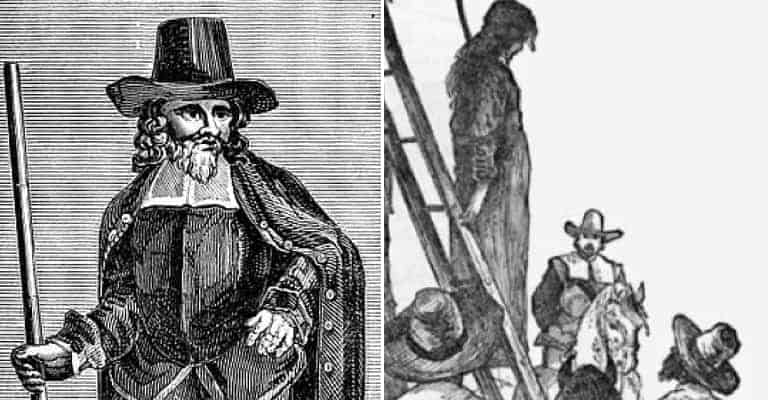The seventeenth century marked a sharp rise in anxiety about witchcraft in the British Isles. The country acquired a witch obsessed King in the form of King James VI of Scotland and new legislation which made any act of witchcraft- benign or malicious- a punishable offense. In the years that followed, fear of witches simmered beneath the surface as religious tensions and a growing suspicion of the old Catholic faith fed social division. This tension increased as the situation between parliament and the monarchy became increasingly strained, finally erupting in the English civil war in 1642.
One person to profit from these chaotic times was an obscure country lawyer named Matthew Hopkins. Hopkins, an ardent Puritan, rose to fame when he became the self-appointed Witchfinder General of England. Historians believe that in three years, Hopkins was responsible for the executions of over 200 ‘witches’ across the southeast of England- not counting the deaths that occurred in custody from Hopkins’s very particular forms of interrogation. In 1647, Hopkins’s activities ceased as quickly as they had begun when the Witchfinder General disappeared. So what led Matthew Hopkins ‘s rise to kill so quickly? And what was his eventual fate?

Matthew Hopkins and the Manningtree Witches
Parish records indicate that Matthew Hopkins was born in Little Wenham in Suffolk sometime around 1619. They suggest that Hopkins was the fourth son of James Hopkins, the Minister of Wenham. James Hopkins died in 1634, leaving the bulk of his estate to his wife Marie, to be divided amongst their six children when they reached the age of twenty-two. The family had deep Puritan leanings. Hopkins’s eldest brother Thomas emigrated to New England while his brother John also became a Minister. However, although well educated, Matthew Hopkins did not go to University or enter the church. Instead, he disappears from the record. He may have completed his education abroad- a circumstance that could have exposed him to the European witch craze.
Hopkins next appears in the records of England in the early 1640’s, when he settled in Mistley as a shipping clerk. From there, Hopkins moved to nearby Manningtree, England’s smallest town where he was either ” a lawyer of but little note,” or a solicitor’s clerk. However, Hopkins’s witch finding activities may already have begun. For records show that the Long Parliament of 1640 had given him a special commission to hunt witches four years before he became the Witch Finder General.
By 1642, the English Civil War had begun. Essex was staunchly pro parliament- and Matthew Hopkins was busy furthering his career. By this time, Hopkins seems to have been a resident of the Thorn Inn in Mistley. Whether he was a tenant or the owner is unknown. However, by this time Hopkins’s would have come into his inheritance so he may well have purchased the property. It was at the inn that Hopkins began to attempt to further himself by entertaining some influential potential friends. One was John Thurlowe, Cromwell’s chief of secret service. Another was William Lilly, a leading astrologer with contacts on both sides of the political divide. Hopkins does not seem to have succeeded in securing advancement. However, two years later, the Thorn Inn became a base of a different kind.

During Christmas 1643, the wife of John Rivet, a Manningtree tailor fell unaccountably ill. Rivet became convinced that a local woman, Elizabeth Clarke, had cursed his wife. Clarke was elderly, poor- and unfortunately the daughter of a convicted witch. Matthew Hopkins immediately scented an opportunity. With the help of with John Stearne, a local ‘gentleman’ and a local woman Mary ‘Goody’ Philips, Hopkins arrested and interrogated Clarke. Using the Thorne Inn as his base, Hopkins managed to persuade the unfortunate woman to confess to her witchcraft.
Clarke also implicated several other local women: Anne West and her daughter Rebecca, Anne Leech, Helen Clarke, and Elizabeth Gooding. She also claimed that other witches from the surrounding areas joined their Manningtree sisters for sabbats held every six weeks in the town. The women were sent to nearby Chelmsford and were tried on July 29, 1645. There, Hopkins told the daring tale of how he had witnessed the witches’ devilry- at the risk of his own life. In all 29 women were condemned to hang. Ten were strung up in Chelmsford, while the rest were hung about the locality to set an example. The witch hysteria had begun- as had Hopkins’s infamous career.

